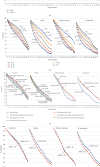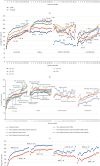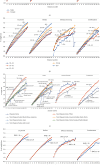Delivering the National Diabetes Prevention Program: Assessment of Retention, Physical Activity, and Weight Loss Outcomes by Participant Characteristics and Delivery Modes
- PMID: 39165352
- PMCID: PMC11335425
- DOI: 10.1155/2024/8461704
Delivering the National Diabetes Prevention Program: Assessment of Retention, Physical Activity, and Weight Loss Outcomes by Participant Characteristics and Delivery Modes
Abstract
Type 2 diabetes disproportionately affects older adults, persons from racial and ethnic minority groups, and persons of low socioeconomic status. It can be prevented or delayed through evidence-based interventions such as the National Diabetes Prevention Program (National DPP) lifestyle change program (LCP). This analysis is aimed at evaluating the outcomes (i.e., retention, physical activity, and weight loss) associated with participation in the National DPP LCP by participant characteristics and delivery mode (i.e., in-person, online, distance learning, and combination) using the 2012-2018 Diabetes Prevention Recognition Program (DPRP) data. Across all delivery modes, there were generally no substantial differences in retention between male and female participants, but male participants tended to have higher physical activity and weight loss (e.g., average weight loss for in-person delivery: 5.0% for males and 4.3% for females). Older participants had better retention rates than younger participants in all delivery modes and mostly higher physical activity and weight loss except for distance learning delivery (e.g., average weight loss for in-person delivery: 5.1% for those aged 65+ and 3.3% for those aged 18-34). Among the seven racial and ethnic groups studied, retention was generally highest for non-Hispanic/Latino (NH)-White participants and lowest for Hispanic/Latino participants. Physical activity varied by racial and ethnic groups and delivery mode. NH-White participants generally had the most weight loss except for distance learning delivery, and NH-Black/African American participants had the least (e.g., average weight loss for in-person delivery: 5.1% for NH-White participants, 3.3% for both NH-Black/African American and NH-American Indian/Alaska Native participants, and other racial and ethnic minority groups ranged from 3.4% to 4.9%). Monitoring and identifying disparities across demographics and delivery modes, particularly across multiple racial and ethnic groups, provides information that can be used to improve the implementation of the National DPP LCP by tailoring the intervention to reduce disparities.
Copyright © 2024 Boon Peng Ng et al.
Conflict of interest statement
The authors declare no conflicts of interest.
Figures



Similar articles
-
Delivering the National Diabetes Prevention Program: Assessment of Outcomes in In-Person and Virtual Organizations.J Diabetes Res. 2023 Oct 26;2023:8894593. doi: 10.1155/2023/8894593. eCollection 2023. J Diabetes Res. 2023. PMID: 37928892 Free PMC article.
-
Surveillance for Violent Deaths - National Violent Death Reporting System, 48 States, the District of Columbia, and Puerto Rico, 2021.MMWR Surveill Summ. 2024 Jul 11;73(5):1-44. doi: 10.15585/mmwr.ss7305a1. MMWR Surveill Summ. 2024. PMID: 38980822 Free PMC article.
-
Retention Among Participants in the National Diabetes Prevention Program Lifestyle Change Program, 2012-2017.Diabetes Care. 2020 Sep;43(9):2042-2049. doi: 10.2337/dc19-2366. Epub 2020 Jul 2. Diabetes Care. 2020. PMID: 32616617 Free PMC article.
-
Assessment of the Inclusion of Racial/Ethnic Minority, Female, and Older Individuals in Vaccine Clinical Trials.JAMA Netw Open. 2021 Feb 1;4(2):e2037640. doi: 10.1001/jamanetworkopen.2020.37640. JAMA Netw Open. 2021. PMID: 33606033 Free PMC article. Review.
-
Translation of the Diabetes Prevention Program to Ethnic Communities in the United States.J Immigr Minor Health. 2016 Apr;18(2):479-89. doi: 10.1007/s10903-015-0209-x. J Immigr Minor Health. 2016. PMID: 25910619 Review.
Cited by
-
Navigating CDC recognition for the National DPP in socially vulnerable communities: barriers, facilitators, and recommendations.Arch Public Health. 2025 Mar 3;83(1):57. doi: 10.1186/s13690-025-01532-4. Arch Public Health. 2025. PMID: 40025587 Free PMC article.
References
-
- What is Diabetes?. Centers for Disease Control and Prevention. https://www.cdc.gov/diabetes/basics/type2.html .
-
- Diabetes and Your Heart. Centers for Disease Control and Prevention. https://www.cdc.gov/diabetes/library/features/diabetes-and-heart.html .
-
- Ohkuma T., Peters S. A. E., Woodward M. Sex differences in the association between diabetes and cancer: a systematic review and meta-analysis of 121 cohorts including 20 million individuals and one million events. Diabetologia . 2018;61(10):2140–2154. doi: 10.1007/s00125-018-4664-5. - DOI - PMC - PubMed
MeSH terms
LinkOut - more resources
Full Text Sources
Medical

